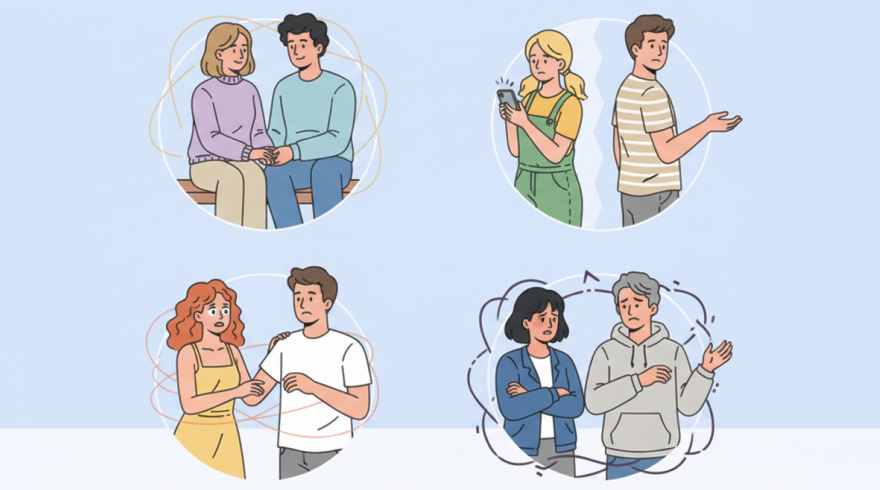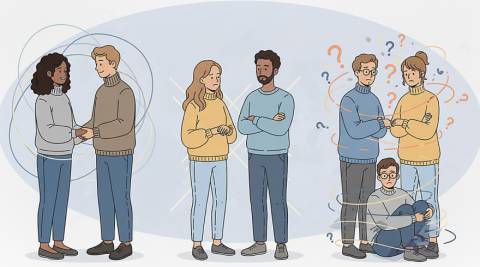A Complete Guide to Different Types Relationships

Understanding Relationship Categories and Why They Matter
Human bonds shape health, happiness, and identity. From early caregiving to adult partnerships, we learn expectations about trust, boundaries, and reciprocity. Recognizing the spectrum of relationship categories helps people choose healthier dynamics, set clearer limits, and invest energy where connection can flourish. This awareness also refines emotional literacy, making it easier to spot mismatches and navigate them with empathy rather than defensiveness.
Clarity about roles, partner, friend, mentor, neighbor reduces confusion and prevents unmet expectations from turning into resentment. Beyond labels, researchers examine how different types of relationships influence wellbeing through boundaries, roles, and expectations in daily life. When you understand how needs like safety, novelty, and recognition operate across contexts, you can better balance independence with closeness. That balance supports resilience during life transitions such as moving, career changes, or caregiving responsibilities.
- Better emotional regulation through predictable norms
- Stronger support networks during stress and recovery
- More satisfying intimacy grounded in consent and communication
- Reduced conflict via aligned expectations and shared language
Finally, understanding relationship categories empowers self-advocacy. People become more adept at requesting what helps a check-in, a boundary, a compromise without guilt. This proactive stance nurtures mutual respect and strengthens bonds over time.
Romantic Bonds: Commitment, Intimacy, and Growth
Romantic connections often combine passion, friendship, and partnership into a single container. The healthiest versions are collaborative, flexible, and responsive to change. Partners who cultivate curiosity about each other’s inner worlds tend to fare better during stress, because curiosity invites validation rather than blame. These couples also invest in rituals of connection shared meals, walks, weekly debriefs that protect closeness from the fast pace of modern life.
Skills like repair after conflict, clear bids for attention, and fair division of labor directly improve satisfaction. Couples counseling often maps how types of attachment styles relationships shape expressions of closeness and autonomy within everyday routines. When partners can name their needs reassurance, space, responsiveness they avoid mind-reading traps and approach disagreements with teamwork. Over time, this approach builds trust that can weather criticism, illness, or financial strain.
- Practice “state of the union” check-ins to track needs and workload
- Use descriptive language instead of accusations during conflict
- Schedule connection time with intention, not just convenience
- Create shared meaning through goals, values, and traditions
Romantic bonds thrive on the interplay of intimacy and independence. Each person nourishes individual interests while lending committed support, forming a resilient partnership that evolves across seasons of life.
Friendship, Support Networks, and Chosen Family
Friendships are voluntary alliances that buffer stress and amplify joy. Unlike kinship, they rely almost entirely on reciprocity and shared experiences, which means maintenance is a conscious choice. Quality friendships feature attentive listening, flexible boundaries, and the freedom to grow without guilt when life stages diverge. Strong social circles also reduce loneliness, a known risk factor for physical and mental health challenges.
Mutuality is key: consistent check-ins, thoughtful favors, and celebration of milestones deepen trust. When conflicts arise, knowledge of attachment types in relationships helps friends repair rifts quickly through reassurance, constructive feedback, and humor. Micro-rituals like monthly game nights or regular walks create predictable contact that keeps connections alive during busy seasons. In times of crisis, friends can mobilize resources, coordinate meals, or simply hold space for feelings.
- Rotate hosting duties to distribute effort and avoid burnout
- Set “response expectations” to reduce misunderstandings
- Use shared calendars to plan gatherings in advance
- Honor differences in energy, schedules, and communication style
Chosen family emerges when friends embody reliability, care, and long-term commitment. These bonds provide a safety net that complements or, at times, substitutes for biological ties, enriching life with belonging and stability.
Family Dynamics Across the Lifespan
Family relationships begin shaping our relational template from the start. Caregiving quality influences emotional regulation, stress responses, and the capacity to seek comfort or autonomy. As families evolve through birth, adoption, divorce, blending, caregiving, and grief roles and boundaries shift. Healthy families renegotiate responsibilities and decision-making power respectfully, allowing each member to grow while sustaining cohesion.
Parenting workshops explain how types of relationship attachment styles emerge from early caregiving and continue into adulthood, affecting sibling bonds and later partnerships. Clear communication, age-appropriate responsibilities, and predictable routines provide a foundation that nurtures both security and independence. When conflict appears, families that focus on shared goals safety, education, wellbeing can collaborate on solutions without scapegoating.
Below is a quick comparison of common family structures and their typical strengths and challenges to aid understanding and planning.
| Family Structure | Common Strengths | Typical Challenges |
|---|---|---|
| Nuclear | Clear roles, stable routines, concentrated support | Limited backup during stress, role rigidity |
| Blended | Expanded support, diverse perspectives, flexibility | Boundary negotiation, loyalty binds, tradition clashes |
| Extended | Shared caregiving, cultural continuity, resilience | Privacy concerns, decision complexity, generational gaps |
- Use family meetings to align values and responsibilities
- Normalize emotion naming to reduce escalation
- Create traditions that include all members equitably
Across life stages, families that adapt with empathy and clarity cultivate healing, belonging, and intergenerational strength.
Professional, Mentoring, and Collaborative Bonds
Workplace relationships influence engagement, creativity, and retention. Healthy collaboration hinges on psychological safety, fair processes, and transparent communication. Mentors provide scaffolding for growth by offering feedback, sponsorship, and strategic introductions. Meanwhile, peers supply camaraderie and practical support, reducing burnout by sharing knowledge and resources.
Teams thrive when leaders understand how types of attachment in relationships affect feedback tolerance and psychological safety within groups. Some colleagues prefer frequent check-ins; others need autonomy and trust by default. Calibrating management style to individual needs boosts accountability without micromanagement. Clear charters, role clarity, and conflict norms keep projects moving even when stakes are high.
- Set explicit decision rights and escalation pathways
- Offer structured feedback windows to avoid surprise critiques
- Pair mentoring with measurable learning goals
- Celebrate small wins to reinforce momentum
When organizations invest in relational skills, they reduce friction, improve innovation, and retain diverse talent. The result is a culture where people feel seen, supported, and motivated to contribute their best work.
Digital, Community, and Cross-cultural Connections
Modern life expands connection beyond geography. Online communities, neighborhood groups, and cultural networks create belonging through shared interests and values. These ties can be deeply meaningful, especially for people whose identities or passions are underrepresented locally. However, digital spaces require careful curation to maintain civility and avoid misinformation or harassment.
Healthy communities establish norms for consent, privacy, and inclusive dialogue. Online spaces reveal how different types of attachment styles in relationships play out through messaging rhythms, response expectations, and tolerance for ambiguity. Moderation policies, clear onboarding, and conflict mediation keep discourse constructive. In cross-cultural contexts, curiosity and humility protect against assumptions and foster mutual learning.
- Create codes of conduct with community input
- Use opt-in channels for high-notification topics
- Provide multilingual resources and accessibility features
- Train volunteer moderators in de-escalation skills
When designed with intention, digital and community spaces become engines of support, knowledge sharing, and civic vitality, enriching both personal growth and collective resilience.
Attachment Science: Patterns, Needs, and Repair
Attachment research explains how early experiences inform later expectations about closeness, distance, and trust. People tend to develop patterns secure, anxious, avoidant, or mixed that guide how they seek support and respond to stress. These tendencies are not destiny; with insight and practice, anyone can cultivate more security through corrective experiences and skill building.
Clinicians often assess types of relationship attachments to tailor interventions for worry, withdrawal, or emotional volatility during conflict. Somatic awareness, compassionate self-talk, and co-regulation exercises help calm the nervous system. Repair conversations work best when partners name impact, take ownership, and negotiate new agreements that prevent repeat injuries.
- Build a shared “soothing menu” for difficult moments
- Practice time-outs that end with reconnection routines
- Use reflective listening to confirm understanding
- Track triggers and progress in a shared journal
Over time, these practices create safer bonds, allowing vulnerability to coexist with autonomy and making intimacy more joyful and sustainable.
Communication Skills and Practical Benefits
Great relationships are built on clear language, boundaries that protect dignity, and habits that reinforce trust. Small behaviors responding to messages, keeping promises, and expressing appreciation accumulate into a climate of reliability. Even during friction, people who use curiosity and specific requests avoid blame spirals and reach solutions faster.
Conflict de-escalation improves when partners identify types of attachments in relationships that can trigger protest, stonewalling, or shutdown during sensitive conversations. Shared planning tools, explicit commitments, and regular check-ins reduce ambiguity and spotlight progress. As confidence grows, people address issues earlier, preventing resentment and preserving goodwill.
- Replace mind reading with direct, kind questions
- Negotiate trade-offs and write them down for clarity
- End tough talks with appreciation and next steps
- Review agreements periodically to keep them current
The practical payoff is significant: smoother collaboration, deeper intimacy, stronger communities, and a durable sense of belonging that supports wellbeing across every area of life.
Faq: Common Questions
How can I tell whether a relationship is mutually healthy?
Look for reciprocity, consistent respect, and room for honest feedback. Healthy bonds show repair after conflict, flexible boundaries, and shared decision-making. If voicing needs brings curiosity rather than punishment, the foundation is likely strong.
What’s the best way to set boundaries without creating distance?
State limits calmly, explain the “why,” and propose alternatives. Boundaries protect connection by preventing resentment. Follow up with appreciation when others honor your limits to reinforce positive cycles.
How do I repair after a hurtful argument?
Start with regulation slow breathing or a brief pause then take ownership for impact. Validate the other person’s experience, clarify intentions, and co-create new agreements. End with a small ritual to mark reconnection.
Can different life stages coexist smoothly in one friendship group?
Yes, if expectations are explicit. Rotate plans to suit varied schedules and budgets, and normalize RSVP flexibility. Emphasize quality over frequency so connection remains stable during busy seasons.
What should leaders do to strengthen team relationships?
Establish clear roles, predictable feedback cycles, and psychological safety norms. Model transparency, invite dissent respectfully, and celebrate incremental progress. These habits reduce friction and boost accountability.
Latest News



